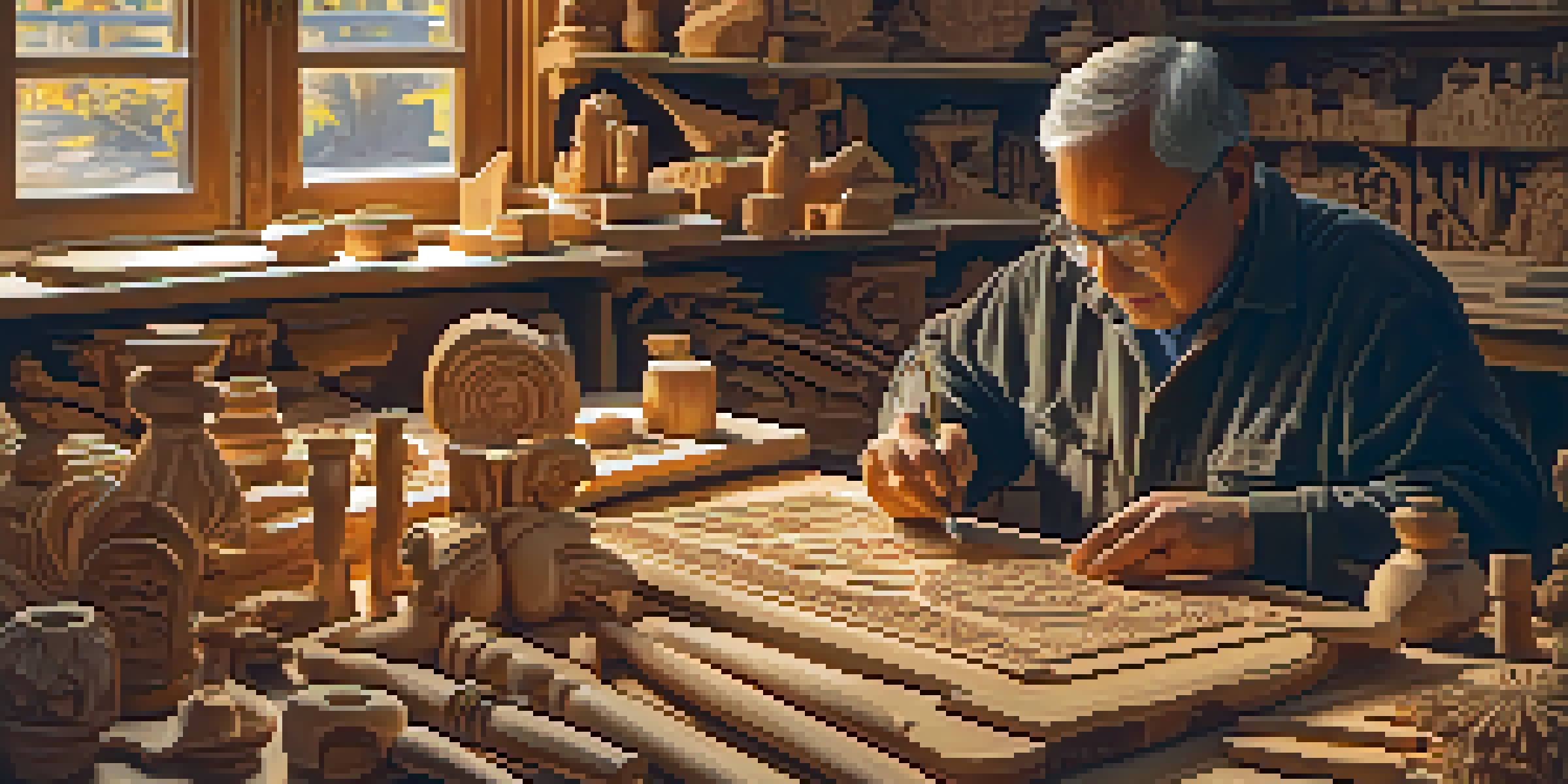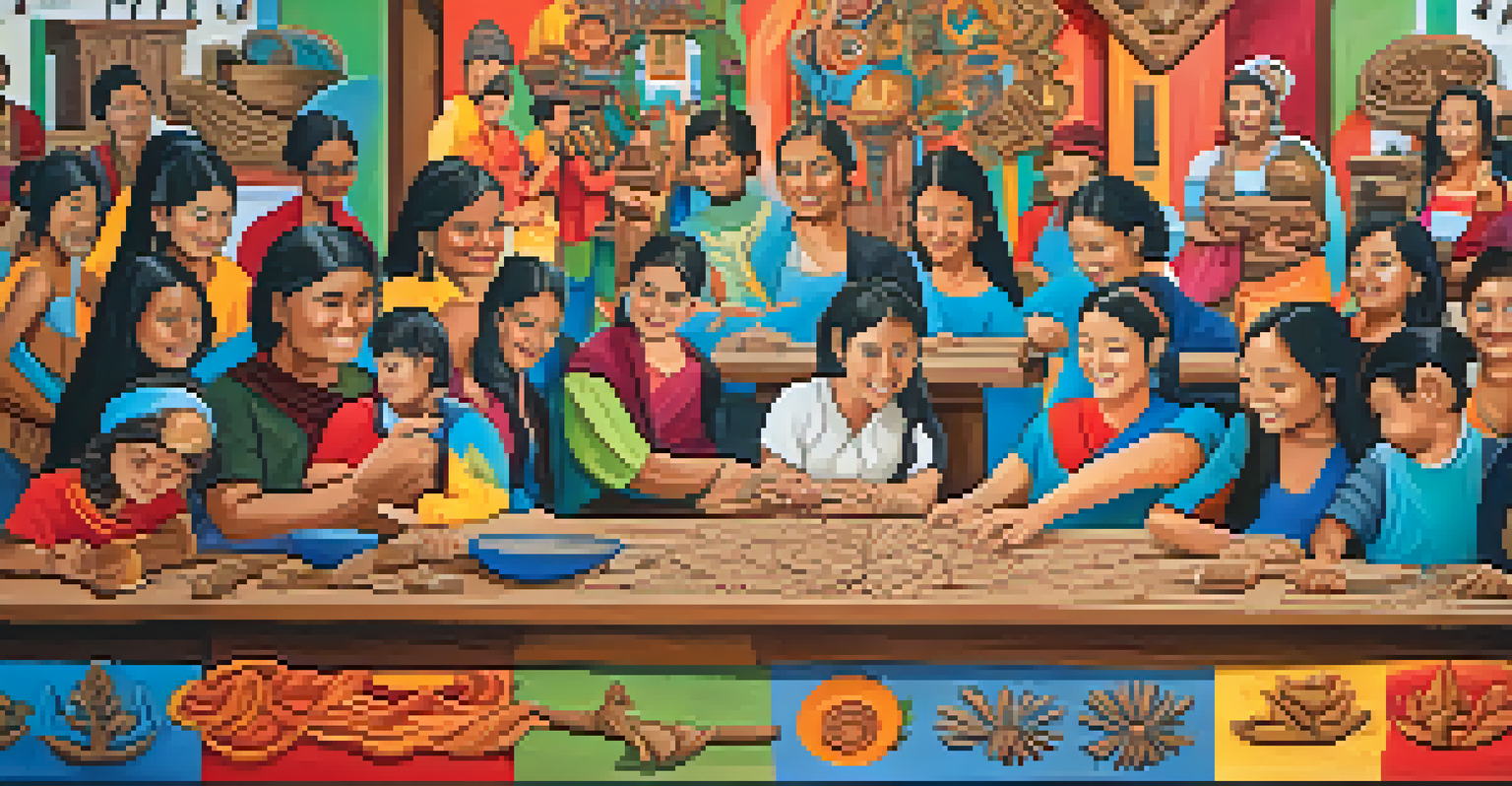From Wood to Stone: Carving as a Cultural Expression

The Historical Roots of Carving in Cultures Worldwide
Carving has been an integral part of human expression for thousands of years, with roots tracing back to ancient civilizations. From the intricate totem poles of Native American tribes to the majestic stone sculptures of ancient Greece, each culture has its unique approach to carving. This form of artistic expression serves not only as decoration but also as a means to convey stories, beliefs, and identities.
Art is a reflection of our times, and carving is a tangible expression of cultural identity that connects us to our past.
Many cultures utilized locally available materials, such as wood and stone, to create their artistic masterpieces. For instance, the Maori of New Zealand are known for their elaborate wooden carvings that tell the stories of their ancestors. Similarly, the ancient Egyptians carved hieroglyphs into stone, preserving their history for future generations. These practices highlight how carving is deeply intertwined with cultural heritage.
As we delve into the world of carving, we see that it acts as both a mirror reflecting cultural values and a bridge connecting generations. By understanding the historical significance of carving, we can appreciate the depth and richness that each piece of art brings to the cultural narrative.
Materials Matter: The Choice Between Wood and Stone
The choice of material in carving is not just about aesthetics; it reflects the culture and environment of the artisans. Wood, being more malleable, allows for intricate designs and is often used in cultures that prioritize storytelling through detailed carvings. For example, the Balinese artisans create beautiful wooden statues that depict local folklore and spiritual beliefs.

On the other hand, stone is often associated with permanence and strength, making it a favored choice for monumental works. Think of the towering statues of Easter Island or the grand cathedrals of Europe. These creations not only showcase skill but also convey messages of endurance and resilience, characteristics that are valued in many cultures.
Cultural Significance of Carving
Carving serves as a vital means of cultural expression, conveying stories, beliefs, and identities across various civilizations.
Ultimately, the material chosen speaks volumes about the cultural identity of the artisans. Each medium offers unique challenges and opportunities, shaping the final artwork and the stories it tells.
Techniques and Traditions: The Art of Carving
Carving techniques vary widely across cultures, with each tradition bringing its own flair to the art form. In Japan, for instance, the technique of Ukiyo-e involves carving intricate designs into wood blocks, which are then used to create stunning prints. This method not only reflects the artistic style of the time but also the cultural importance of storytelling through visual art.
Every piece of art is a story waiting to be told, and carving transforms the ordinary into the extraordinary through the hands of skilled artisans.
Conversely, in many African cultures, the use of chisels and hand tools creates bold, expressive figures that often serve spiritual purposes. Each stroke and detail tells a story, often linked to the community's history or beliefs. This hands-on approach emphasizes the connection between the carver and their culture, showcasing a shared heritage.
By examining these techniques, we gain insight into the values and narratives that shape a culture. Each carved piece is a testament to the skills passed down through generations, preserving both artistry and tradition.
Symbolism in Carving: More than Meets the Eye
Beyond aesthetics, carving often carries profound symbolism within various cultures. For example, in Celtic traditions, intricate knotwork and spirals carved into stone represent the interconnectedness of life and eternity. These symbols are deeply rooted in cultural beliefs and showcase the carver's intent to convey a deeper message.
Similarly, in many Indigenous cultures, carvings often feature animals or natural elements that hold significant meaning. In Native American art, the bear is frequently carved to symbolize strength and courage, while the eagle represents freedom and spirit. Each carving is a dialogue between the artist and the viewer, inviting interpretation and reflection.
Materials Reflect Cultural Identity
The choice between wood and stone in carving not only impacts aesthetics but also reveals the cultural values and environment of the artisans.
Understanding the symbolism behind these carvings enriches our appreciation for the art itself. It invites us to look beyond the surface and explore the stories and beliefs that shape cultural identities.
Modern Carving: Blending Tradition with Innovation
Today, the art of carving continues to evolve as contemporary artists blend traditional techniques with modern influences. Many artisans are experimenting with new materials, such as synthetic substances, while still honoring the age-old practices. This fusion creates unique artworks that resonate with both historical significance and contemporary relevance.
For instance, some artists are using reclaimed wood and stone to create pieces that not only tell a story but also highlight environmental awareness. This innovative approach demonstrates a commitment to sustainability while preserving cultural practices. It’s a beautiful example of how the past and present can coexist in artistic expression.
As we witness this evolution, we recognize the importance of keeping cultural narratives alive while embracing change. Modern carving is a testament to the resilience of art as it adapts to the ever-changing world around us.
Carving as a Community Activity: A Shared Experience
In many cultures, carving is not just an individual endeavor; it’s often a community activity that brings people together. Workshops and festivals dedicated to carving allow artisans to share skills and stories, fostering a sense of camaraderie. This collective experience strengthens cultural ties and encourages the passing down of traditions to younger generations.
For example, in some Indigenous communities, carving workshops are organized to teach youth the traditional methods of their ancestors. Participants learn not only the technical aspects of carving but also the cultural significance behind each piece they create. This mentorship helps keep cultural narratives alive and relevant in an ever-globalizing world.
Innovation Meets Tradition in Carving
Modern carving blends traditional techniques with contemporary materials, fostering sustainability while preserving cultural heritage.
Community carving activities highlight the importance of collaboration and shared heritage. They remind us that art is not just about the final product but also about the connections forged through the creative process.
The Future of Carving: Preserving Cultural Heritage
As we look to the future, the challenge remains to preserve the rich cultural heritage associated with carving while embracing modern techniques. Many artisans face the risk of losing traditional skills due to globalization and changing societal values. However, there is a growing movement to document and promote these practices through online platforms and community engagement.
Efforts to archive traditional carving techniques and stories are crucial in maintaining cultural identity. Many organizations are working to create resources that highlight the significance of carving in various cultures, ensuring that future generations can learn and appreciate these art forms. This preservation work is invaluable for fostering understanding and respect across cultures.

Ultimately, the future of carving lies in balance—honoring the past while innovating for the present. By valuing both tradition and modernity, we can ensure that this beautiful form of artistic expression continues to thrive.